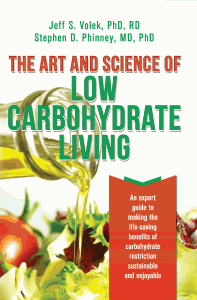
 As I mentioned in part 1,
Stephen Phinney and Jeff Volek's book
The Art and Science of Low Carbohydrate Living
is what convinced me to give a LCHF diet
a shot.
As I mentioned in part 1,
Stephen Phinney and Jeff Volek's book
The Art and Science of Low Carbohydrate Living
is what convinced me to give a LCHF diet
a shot.
The full title is "The Art and Science of Low Carbohydrate Living: An Expert Guide to Making the Life-Saving Benefits of Carbohydrate Restriction Sustainable and Enjoyable". Here, cut and pasted from the book's amazon page, are the main points that convinced me:
Point 2 is what really convinced me to try carbohydrate restriction. When keto-adapted, your body converts fat to ketones, which it can then use as fuel. I had been under the mistaken impression only glucose could fuel your brain and muscles. With my overabundance of stored fat, even if I restricted calories to lose weight, my body could have a virtually unlimited, constant supply of fuel. It actually sounded too good to be true, but I was excited to give it a try.
Point 3 was somewhat shocking given the conventional wisdom, which villifies saturated fat. The book shows that saturated fat is actually a preferred fuel if you are keto-adapted, and that polyunsaturated fat is inflammatory. Point 4 was also surprising. When keto-adapted, your body excretes extra sodium, so you need to ingest more to make up for it. Points 3 and 4 together loosely translate to being able, nay, encouraged, to eat salty, fatty foods. What's not to love about that?
Point 5 is why I really loved the book. It's based on scientific research, not opinion. Instead of being filled with a "for dummies" blend of fluff and recipes, the book explains the science behind carbohydrate restriction and methodically busts the myths put forth by LCHF opponents, using scientific research, not popular belief. Since the book is written for doctors, it assumes an educated, intelligent audience, which was the most refreshing part of all.
In summary, if you are interested in carbohydrate restriction, and especially if you want to know the science behind it, I highly recommend this book.
The next post in this low carb diet series will focus on my results so far. Stay tuned!
The Seeking42 low carb diet series
(note: this list will be updated as articles are added):